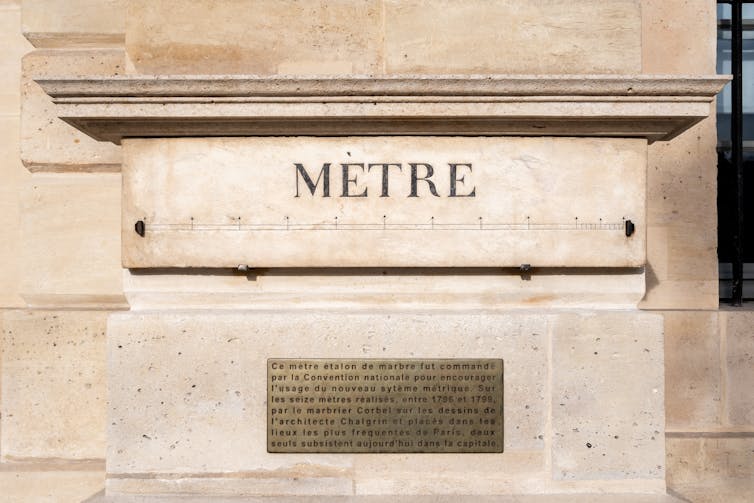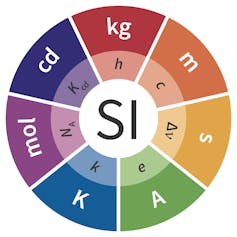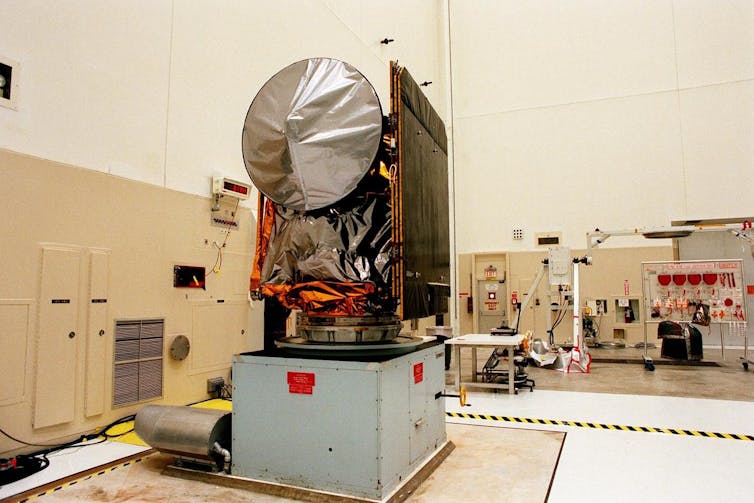Detta inlägg post publicerades ursprungligen på denna sida this site ;
Date:
Author: Jonathan Simone, Adjunct Professor of Biological Sciences, Brock University
Original article: https://theconversation.com/150-years-ago-the-metre-convention-determined-how-we-measure-the-world-a-radical-initiative-for-the-time-252108

On May 20, 1875, delegates from a group of 17 countries gathered in Paris to sign what may be the most overlooked yet globally influential treaty in history: the Metre Convention.
At a time when different countries (and even different cities defined weights and lengths based on local artifacts, royal body parts or grains of wheat, this rare agreement among nations offered something simple yet undeniably impactful: consistency.
A radical initiative for its time, the Metre Convention ultimately birthed a system of measurement that would transcend language, politics and tradition, and lay the foundation for a new global era of scientific and technological advancement.

(Shutterstock)
A world divided by measurement
By the mid-19th century, the push for standardization had become increasingly urgent. Scientific discovery was accelerating, global trade was booming and industrial projects were growing in scale and complexity. But the world’s measurements were, frankly, a mess.
France had introduced the metric system during its revolutionary years, but other nations were slow — or outright unwilling — to adopt it.
Rivalries simmered not just among empires, but within the scientific community itself. Astronomers couldn’t compare celestial observations across borders because their units didn’t match. Engineers designing railway systems across Europe had to navigate conflicting standards for track gauges, load weights and even timekeeping.
This wasn’t just inefficient. It was a barrier to progress, a strain on economies and a growing source of frustration or a scientific world that aimed to speak in universal truths.
Faced with growing societal demands, the industrial world agreed it was time to act. The Metre Convention was the result.
Scientists and diplomats representing the 17 participating countries collectively established the Bureau International des Poids et Mesures (BIPM), headquartered just outside Paris, as the official keeper of measurement standards. Today, the BIPM is backed by 64 member states and governs the Système International d’Unités (SI), the measurement framework that underpins everything from bridges to smartphones.
When standards fail

(Bureau International des Poids et Mesures), CC BY-ND
And while by today’s standards, the SI may seem like a relic of old-school science bureaucracy, it’s anything but. Standardized measurement is the invisible infrastructure of the modern world. And when it fails, or more specifically when we ignore it, the consequences can be severe.
Take the Gimli Glider incident. In 1983, an Air Canada flight from Montréal to Edmonton ran out of fuel midway through its journey. The cause was a miscalculation caused by confusion between metric and imperial units: the ground crew had used pounds instead of kilograms to measure fuel, and the pilots didn’t catch the error.
The plane lost power at 41,000 feet (around 12,500 metres for those who prefer their near-death experiences in metric), and glided safely to an abandoned airstrip in Gimli, Man., and to the annals of history as a symbol of what happens when we take standards for granted.
Or consider the Mars Climate Orbiter, a US$327 million NASA spacecraft that disintegrated upon entering Mars’ atmosphere in 1999. Engineers at Lockheed Martin had used imperial units, while NASA had assumed metric. The mismatch led to a critical navigation error and the failure of the mission, highlighting the importance of consistency in measurement, even far beyond the confines of Earth’s atmosphere.
The Gimli Glider and Mars Orbiter failures show what happens when consistency breaks down, but they’re more than just cautionary tales. They reveal how much of modern life depends on the shared language of measurement, and how easily that foundation can be cracked.
And therein lies the genius of the Metre Convention. It created a system that allows the world to communicate in the same terms. When someone says “kilogram,” “second” or “volt,” there is no ambiguity. That shared understanding is what makes global collaboration possible.

(NASA/KSC)
From man-made objects to universal constants
But as scientists are wont to do, good ideas are refined, and standards evolve. For much of its post-Metre Convention history, the kilogram was defined by a physical artifact — a hunk of platinum-iridium alloy stored in a vault in France. But in 2019, that changed. Now, the kilogram is defined by Planck’s constant, a fundamental feature of the universe. The shift marked the final step in a long journey: every base unit in the SI is now rooted in nature rather than arbitrary human artifacts.
Read more:
Redefining the kilogram means redefining how we measure wealth
That change wasn’t just symbolic, it was necessary. Our ability to measure time, mass and distance with extreme precision affects nearly every aspect of modern life.
GPS signals rely on time measurements accurate to the billionth of a second. Quantum computers and particle accelerators require calibration on mind-bendingly small scales. Even weather forecasting depends on standardized measurements of pressure, temperature and humidity.
Shared standards in a divided world
But perhaps the most underrated legacy of the Metre Convention is its role in building trust across borders.
At a time when misinformation spreads quickly and even basic facts are contested, international standards offer a shared foundation that scientists, governments and industries can rely on. It’s a form of global co-operation that has quietly endured for 150 years.
That co-operation becomes particularly apparent in moments of political strain. Although the United States appears uncompromising in its commitment to feet and inches, American scientists, engineers and manufacturers rely heavily on the metric system, especially when collaborating across borders.
As tensions rise between close allies like the U.S. and Canada, metric standards remain a consistent point of harmony. The two countries may spar diplomatically, but when it comes to assembling a car in Windsor with parts made in Detroit, the bolts still fit.
Looking ahead
Still, like all institutions, BIPM and the SI reflect the times in which they were created. The original signatories were almost exclusively colonial powers. It took almost a century for other nations to gain an equal seat at the table, and even now, access to the tools and infrastructure that facilitate precision metrology — the act of taking extremely accurate measurements — remains unequal.
If the next 150 years of the Metre Convention are to be as successful as the first, greater inclusivity and accessibility will need to be central to its mission.
We live in a world held together by decimals, tolerances and agreed-upon constants that keep planes in the air, bridges from collapsing and scientific progress on track.
The Metre Convention reminds us that science isn’t only about big breakthroughs and bold ideas. Sometimes it’s about consensus and agreeing, together, on what a metre actually is. And even after 150 years, the simple idea of agreeing how to measure the world remains one of humanity’s greatest achievements.
So, what should we do with this anniversary? Maybe throw a party with metric-themed cocktails (may I suggest a 100mL Old Fashioned?). At the very least, we should take a moment to reflect on just how essential, and how easy to overlook, measurement really is.
![]()
Jonathan Simone does not work for, consult, own shares in or receive funding from any company or organisation that would benefit from this article, and has disclosed no relevant affiliations beyond their academic appointment.

